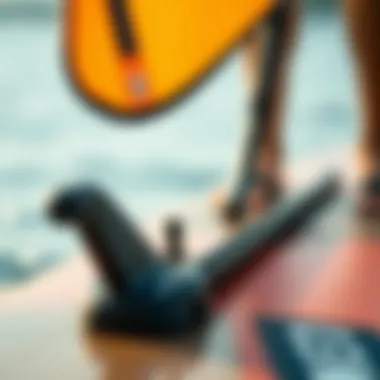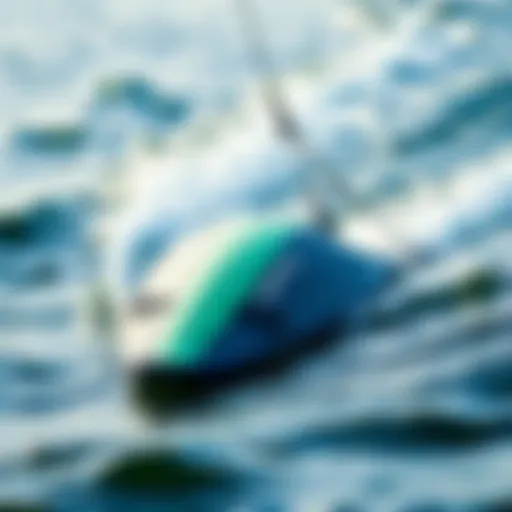Exploring Foil SUP Boards: A Comprehensive Guide


Intro
The world of water sports is continuously evolving, and one of the most fascinating advancements in recent years is the emergence of foil stand-up paddle boards (SUP). These boards are distinct from traditional ones, offering a unique riding experience that elevates riders above the water's surface. Imagine gliding without the resistance of waves—this is the allure of foil SUP boards. But, what makes them tick? This guide ventures into every nook and cranny of foil SUP boards, from design nuances to the exhilarating techniques required to master this sport.
Understanding foil SUP boards means diving into a blend of design and physics that creates a fluid and enjoyable ride. This guide aims to equip enthusiasts at any skill level with the insight to elevate their SUP game. We will dissect the materials used in construction, the hydrodynamic principles that facilitate those smooth rides, and riding techniques that separate the novice from the seasoned rider. Safety measures and maintenance practices will also feature prominently, ensuring that you can enjoy every ride without a hitch. Lastly, keeping an eye on future trends will help both new and veteran riders navigate the ever-changing landscape of foil sports.
Whether you're a kiteboarder looking to broaden your horizons or a newcomer eager to catch that first wave, this guide is tailored for you. Let's take a dive into the waves of knowledge that surround foil SUP boards.
Gear Insights
To embark on your foil SUP journey, having the right gear is essential. The following insights will shed light on what’s currently available in the market and what gear can boost your experience.
Latest Gear Reviews
When considering foil SUP boards, it's crucial to stay updated on the latest innovations. For instance, the Starboard Hyper Foil and Slingshot Infinity 84 are making waves, pun intended. These boards boast excellent stability and speed, allowing riders to hone their skills without fear of losing balance.
- Starboard Hyper Foil: Known for its lightweight structure, engineered for both speed and maneuverability.
- Slingshot Infinity 84: Provides a smooth ride, perfect for beginners transitioning to advanced techniques.
Before making a purchase, ensure you check out user reviews on platforms like Reddit and Facebook Groups where experienced riders often post their hands-on experiences.
Essential Gear for Beginners
If you're just starting out, you don't need to break the bank for the best products. Focus on the basics:
- A stable board designed for beginners. Look for wider boards for added balance.
- A reliable paddle made of lightweight material. Your arms will thank you later!
- Safety gear such as life vests and helmet, especially for skittish waters or windy days.
Choosing the right gear lays the foundation for a fulfilling experience. A little preparation goes a long way in ensuring you’ll be riding the waters like a pro in no time.
Stay tuned for the next sections, where we will explore techniques and tips to refine your skills further.
Prologue to Foil SUP Boards
Foil stand-up paddle boards have emerged as a fascinating realm within the broader surfing and paddle boarding community. What sets foil SUPs apart is their ability to rise above the water, gliding effortlessly while drastically reducing drag. This capability not only enhances speed but also opens up new horizons for adventure enthusiasts. For those curious about the nuances of this approach, a closer look at foil SUP boards is essential.
Definition of Foil SUP
A foil SUP is essentially a stand-up paddleboard equipped with a hydrofoil. A hydrofoil consists of a wing-like structure that extends below the board, allowing the board to lift above the water as it gains speed, resulting in a uniquely smooth ride. This lift effect is akin to flying just above the waves, which creates a surreal experience, especially for newcomers to the sport.
The mechanics of this setup can be somewhat daunting at first. Imagine cruising along with just the right balance. The water beneath can feel calm while you're above it, making it an incredible experience. Foil SUP boards present an opportunity for riders to transcend the traditional limitations of paddle boarding, ushering in a new era of performance and excitement.
Evolution of SUP Technology
The journey of stand-up paddleboards started quite differently. Initially, these boards were heavily influenced by the longboards of surfing, designed purely for stability and floatation. However, as the sport grew, so did innovations in the materials and designs used. The transition towards incorporating foils began when enthusiasts sought to experiment and optimize their performances in various water conditions.
The introduction of foiling into SUP technology can be traced back to the burgeoning kiteboarding and windsurfing communities. These sports utilize similar hydrofoil technology, proving successful on unique paths on the water. In recent years, the popularity of foil SUP boards has skyrocketed, driven largely by advances in performance materials like carbon fiber and epoxy, allowing for lighter and stronger boards. Nowadays, many boards are custom-designed to cater to specific styles of riding, whether it be surfing, flatwater cruising, or even racing.
To summarize, the development of foil SUP boards highlights the innovative spirit of water sports enthusiasts, where creativity marries technology. As the sport continues to make strides, each improvement opens up possibilities for both experienced riders and novices alike. Understanding these elements lays the groundwork for developing skills and engaging with the dynamic world of foil SUP boards.
Understanding the Mechanics
Understanding the mechanics behind foil stand-up paddle boards (SUPs) is essential for recognizing how these innovative boards operate on the water. The interplay between design and function is what sets foil SUPs apart from traditional boards. By grasping the mechanics of foiling, enthusiasts can appreciate the unique performance characteristics, making them better equipped to choose and utilize their equipment effectively.
How Foiling Works
Foiling involves harnessing hydrodynamic lift. When a board with a foil attached accelerates, the interaction between the water flowing over the foil creates lift which elevates the board above the surface. This process reduces drag and allows for smoother navigation over choppy water, providing a sense of gliding that is both exhilarating and serene. Understanding this principle gives paddlers insights into how to manipulate speed and weight distribution to optimize their ride.
The lift generated by the foil changes with speed and angle. At lower speeds, you’ll find the board remains close to the water’s surface. But once sufficient velocity is achieved, the board lifts up, allowing for greater efficiency. It’s this delicate balance between speed, angle, and weight that makes mastering foil SUP riding a blend of art and science.


Components of a Foil SUP
Board design
The board design significantly influences the overall performance of a foil SUP. The shape, volume, and length of the board can affect stability, speed, and the rider’s ability to maneuver through varying water conditions. A well-crafted foil board typically features a longer outline with a narrower width, which allows for streamlined movement through the water and facilitates the lift needed to foil effectively.
An essential characteristic of board design is its tail shape. Boards with a rounded tail may offer better stability, especially for beginners, while those with a square tail can shift the board’s performance towards speed and agility, beneficial for skilled riders looking to perform tricks. Each design comes with its own set of advantages, depending on the rider's skill level and intended use.
Foil assembly
Foil assembly consists of three main parts: the mast, the front wing, and the rear wing. This assembly is crucial because it dictates how the board interacts with the water. The mast connects the board to the wings and is a key factor in determining the height at which the board rides above water. A longer mast typically allows for higher rides, crucial for navigating waves or choppy conditions.
A notable aspect of foil assembly is the wing shape. Wings can vary significantly in size and design, affecting lift and speed. A larger front wing offers more lift at lower speeds but can create more drag, particularly in high-speed settings. For those seeking versatility, understanding your foil assembly and tailoring it to your riding style can vastly improve performance.
Fins and their roles
Fins serve as stabilizers and are another crucial component of a foil SUP setup. Unlike traditional paddle boards that rely heavily on fin design to track straight in the water, the dynamics change with foiling. While fins still provide directional stability, their placement and design can influence how a rider maneuvers and corners.
A key characteristic of fins in this context is their flexibility. Some fins are stiff for better performance in strong currents, while others offer more flexibility, enhancing turning capabilities. The choice of fin can greatly affect performance, especially for those pushing their limits in intense conditions.
Overall, each of these elements—board design, foil assembly, and fins—plays an integral role in how a foil SUP performs in various water environments. Riders must not only choose their components wisely but also have a deep understanding of how they interact to elevate their riding experience.
Material Considerations
When it comes to foil SUP boards, the materials used in their construction play a critical role in shaping their performance, weight, and durability. Choosing the right materials can be the difference between an enjoyable day on the water and a frustrating experience. This section will explore the common materials utilized, their characteristics, and their impacts on the overall performance of foil SUP boards.
Common Materials Used
Epoxy and fiberglass
Epoxy resin combined with fiberglass cloth has become the staple in board manufacturing. This duo creates a lightweight yet incredibly strong structure, allowing for flexibility without compromising durability. The unique characteristic of epoxy is that it cures harder and provides better bonding than its polyester counterpart, which is critical, especially under the strain of foiling.
The key advantage of this material combination is its resilience under adverse conditions. When paddling through choppy waters or dealing with impacts from waves, epoxy and fiberglass offer reliability to riders. Though it may come at a higher price than other options, many enthusiasts see it as a worthwhile investment given the added performance benefit.
A potential downside lies in repairability; though durable, if a board does take a significant hit, damages can be harder to fix compared to other less rigid materials.
Carbon fiber
Carbon fiber is considered the high-performance option in the world of foil SUP boards. It is known for its exceptional strength-to-weight ratio, making boards both light and incredibly stiff. This has a direct impact on maneuverability and responsiveness on the water.
The standout feature of carbon fiber is its ability to transfer energy efficiently, enhancing speed and allowing riders to chop through water with less effort. This particular material choice makes carbon fiber boards popular among seasoned riders who prioritize responsiveness and performance.
On the flip side, the cost is significantly higher, and for beginners, it might be more than what they need, as the unique advantages may not be fully appreciated until a rider reaches a certain skill level.
Foam cores
Foam cores are an eco-friendly option and are often used as the backbone structure of many foil SUP boards. They are lightweight and help in buoyancy, making them easier to paddle. Thhe structure can also be less rigid compared to others, providing a forgiving ride, especially suitable for beginners.
What's remarkable about foam cores is their versatility in design. Adding various reinforcements, such as fiberglass or epoxy layers, can enhance durability while maintaining lightness. Foam can be a more affordable choice for those getting started in the sport, making it enticing for novice riders looking to test the waters without breaking the bank.
However, they tend to be less durable than their carbon fiber or epoxy counterparts; punctures or impacts can lead to issues if not dealt with promptly. The care taken in transport and use also becomes a more considerable factor for their longevity.
Impact of Materials on Performance
The materials chosen have a direct relationship to the overall performance of foil SUP boards. Here are key factors:
- Weight: Lighter boards, often made from carbon fiber or foam cores, allow for enhanced agility and speed but require careful handling.
- Durability: Boards made from epoxy and fiberglass stand up against wear and tear better than less robust materials.
- Flexibility: The balance between stiffness and flex can significantly impact ride comfort, with foam cores often offering a more forgiving ride.
- Cost: Material choice also dramatically affects the price of a foil SUP board. More advanced materials may improve performance but can also strain initial budgets.
Ultimately, understanding the implications of material choices informs riders about what suits their needs best, influencing their purchasing decisions.


For further reading on materials and their efficiency within water sports, check out sources like Britannica and Wikipedia.
Performance Assessment
Evaluating the performance of foil stand-up paddle boards is vital for enthusiasts, ranging from beginners to seasoned pros. Understanding how these boards respond to different conditions can significantly affect a rider's experience on the water. The right balance of speed, agility, and stability not only contributes to an enjoyable ride but also enhances safety. Performance assessment dives deep into these aspects, offering insights that can make or break a foiling session.
Speed and Agility
When it comes to speed, foil SUP boards excel in ways traditional paddle boards can’t touch. The foil itself acts like an underwater wing, lifting the board above the water's surface as speed increases. This minimizes drag and allows for thrilling speeds that can leave a rider feeling exhilarated.
Being agile is another matter. Speed is great, but if a board is hard to maneuver, it can create challenges. The design of the board, coupled with the skill of the rider, plays a significant role in how agile the setup is. Shorter boards typically offer more responsive turning capabilities, while longer ones may allow for greater maximum speeds but can feel a bit cumbersome to steer.
Here are some factors to consider regarding speed and agility:
- Board Size: Smaller boards usually allow for tighter turns and quicker responses.
- Weight of the Rider: Heavier riders may require larger boards to achieve optimal speed.
- Water Conditions: Choppy waters can hinder speed, while flat water can give a significant boost.
Stability on Water
Stability in foil SUP boards is often regarded as the foundation that supports a good riding experience. Riders must feel secure while navigating waves and gusts of wind. Stabilit lies not only in the design of the board but also in the rider's positioning and skill level. Low stability can lead to discomfort or falls, which can detract from the joy of riding.
When evaluating stability, several factors come into play:
- Foil Positioning: The placement of the foil can alter the center of gravity, impacting stability.
- Board Width: Wider boards provide more surface area, offering greater balance and control.
- Rider Technique: A rider's stance and ability to shift weight effectively can improve or hinder stability.
"Stability doesn't just happen; it’s developed through practice and understanding the balance between the board and rider."
In short, performance assessment plays a crucial role in the world of foil SUP boards. With the right insights and practices, riders can enhance their experience and maximize their time spent on the water. Whether you're looking for the thrill of speed or the security of a stable ride, knowing these key performance factors can help shape a fulfilling foil SUP adventure.
Techniques for Foil Riding
Understanding the techniques for foil riding is essential for those who want to master this exhilarating water sport. The way you position your body and maneuver your board can greatly influence your performance. It's not just about balancing; it's about dancing with the water beneath you. Having the right techniques allows riders to harness the natural elements effectively, enabling smoother rides and more impressive tricks. Learning these methods not only enhances your experience but also keeps you safer on the water.
Basic Stance and Body Position
The fundamental aspect of foil riding kicks off with your stance. A solid base can make all the difference. You typically want to adopt a shoulder-width stance, keeping your feet parallel but not too rigid. Bending your knees is crucial for absorbing the energy from the waves.
Your body positioning also plays a vital role. Leaning slightly forward can help you catch the lift provided by the foil. If you tend to lean back, expect a splash or, worse, a tumble. You should distribute your weight evenly; placing more weight on your front foot often results in smoother takeoffs. As you become more comfortable, experiment with shifting your weight based on the water conditions.
Make it a habit to keep your core engaged. This stability will support your movements and help adjust to shifts in the water. Remember, your hands and arms aren’t just for balance, they’re for steering too. Stay relaxed, but be ready to respond to the board or wind. Here are a few tips for achieving the perfect stance:
- Foot placement: Ensure your feet are roughly where the strap or pad ends.
- Body lean: Stay slightly forward for lift; shift as needed but avoid extremes.
- Knees bent: This allows better shock absorption and balance.
Maneuvering and Turning
Once you’ve got the basic stance down pat, the next step is mastering maneuvering and turning. Navigation on a foil SUP is about precision and rhythm, more akin to a ballet than a wrestling match. You need to understand how to shift your weight fluidly to initiate turns without losing lift.
When starting to turn, tilt your body in the direction you want to go, engaging your core to guide your movement. Keep your hips and shoulders aligned as much as possible with the direction of travel. This is where many riders stumble; they tend to lean too far or make abrupt movements, which can lead to losing balance. A gentle turn often ends up being more effective than an aggressive one.
To enhance turning:
- Practice carving: Use your pressure to initiate smooth, rounded turns.
- Back foot pressure: Apply light pressure on your back foot to help pivot your board.
- Head and gaze: Look where you want to go; your body usually follows your head.
Advanced Tricks
After understanding the basics and refining your turning techniques, you might find yourself itching to take it up a notch. Advanced tricks can be the crown jewels of foil riding, as they not only showcase skill but also creativity. However, they come with their own set of risks and considerations.
Tricks like jumps and flips rely heavily on your confidence and timing. One prominent move is the “air”, where riders launch off a wave and momentarily defy gravity. It requires fine-tuning not only in execution but also in your body’s orientation in the air. Landing well is crucial to prevent a face-plant. Remember to build up to these maneuvers; start with simpler tricks such as a basic tail grab or a small jump, then progress.
A few pointers for acing advanced tricks include:


- Momentum is key: Use the power from the wave or wind to assist your maneuvers.
- Practice consistently: Tricks won’t come overnight; repetition is your best friend.
- Stay focused: Mindset matters as much as technique; mental preparation is as important as physical readiness.
Incorporating these techniques into your foil riding routine can elevate your experience. Remember, practice makes perfect, and embracing these methods consistently will lead to a more gratifying time on the water. Foil riding is ultimately about enjoying the journey and connecting with nature on a new level.
Safety and Precautions
When it comes to foil SUP boards, understanding safety and precautions is crucial for both enjoyment and preservation of health. Foil riding, while thrilling, involves certain risks; hence, taking the appropriate measures can make all the difference. This section delves into what you need to know to stay safe while catching waves or gliding over calm waters.
Essential Safety Gear
Before you step onto your foil SUP board, make sure you’re equipped with essential safety gear. A little preparation goes a long way in ensuring a safe experience on the water. Consider these important items:
- Life Vest: Always wear a properly fitted personal flotation device (PFD). Not all rivers and ocean areas are the same; thus, rules about wearing a PFD may differ based on location.
- Helmet: Protecting your head is vital. A well-fitted helmet will guard against impact from any falls, bumps, or collisions with the board or other objects in the water.
- Leash: A reliable board leash is crucial, keeping your board tethered to you, especially if you wipe out. It prevents the board from drifting away and possibly becoming a hazard for other water users.
- Foot Protection: Some riders choose to wear booties to protect their feet from sharp objects or hot surfaces. Even in shallow waters, it's better to play it safe.
- Sunglasses or Goggles: Protect your eyes from the sun's glare or wind, ensuring you maintain visibility. Look for options that resist impact and provide good UV protection.
Investing in the right safety gear is about ensuring an enjoyable experience, not just for yourself, but for fellow water enthusiasts as well.
Understanding Environmental Risks
Riding on foil SUP boards is an exhilarating activity, yet it is imperative to understand the environmental risks that can accompany it. The elements play a significant role in your adventure, and being aware of these factors can make your outings more secure:
- Weather Conditions: Check the weather forecast before heading out. Sudden changes in weather can create dangerous situations. High winds, storms, or even lightning can pose severe threats.
- Water Conditions: Pay attention to the current state of the water. Rough waves or strong tides can alter your ride and increase the likelihood of accidents. Know the specific waterway you will be riding on, as conditions can vary dramatically.
- Wildlife Awareness: Depending on where you are, you may encounter wildlife, such as jellyfish, sharks, or other aquatic animals. Educate yourself about the region’s wildlife to avoid unpleasant surprises.
- Navigation Hazards: Look out for rocks, logs, and other obstacles that could cause injury. Ideally, familiarize yourself with the area beforehand and plan your route to avoid these dangers.
By understanding these safety measures and environmental considerations, you can refine your skills while minimizing risks associated with foil SUP. Ensuring proper gear and knowledge allows you to explore the water with confidence and peace of mind.
Maintenance of Foil SUP Boards
Maintaining a foil stand-up paddle board is crucial not just for extending its life but also for ensuring optimal performance on the water. Just as a well-tuned instrument plays more melodiously, a well-maintained SUP can glide smoothly through the waves. Without proper care, performance can badly suffer, leading to an unproductive experience and possibly a damaged board. Besides, a little effort in maintenance can save you big bucks on repairs down the line. It’s a no-brainer.
Cleaning and Care Tips
Cleaning your foil SUP should become part of your routine after each session on the water. Here are some simple yet effective tips to keep your board in peak condition:
- Rinse with Fresh Water: After every use, especially in saltwater, rinse your board with fresh water. This helps to remove salt, sand, and other debris that can degrade materials over time.
- Drying: Don't just toss your board away wet; give it time to dry. Leaving water on it for extended periods can lead to mold and bad smells.
- Use a Soft Cloth: For stubborn stains, use a soft cloth or sponge with gentle soap. Avoid harsh chemicals that could damage the surface.
- Check for Dings: Keep an eye out for any dings or scratches on your board. Addressing minor damages now can prevent bigger problems later.
- Store Properly: When not in use, keep your foil SUP in a cool, shaded area out of direct sunlight. Prolonged exposure to the sun can cause fading and weaken the board's materials.
Troubleshooting Common Issues
Despite the best care, issues may still arise. Here’s a breakdown of common problems you might face while using a foil SUP and how to troubleshoot them:
- Water Leaks: If you notice your board taking on water, it might have a puncture or crack. Inspect the board carefully. If water damage is confirmed, a repair kit for SUP boards can be your best friend.
- Foil Attachment Issues: Sometimes the foil can become loose, which can affect performance. Regularly check the screws and bolts holding the foil in place and tighten them as needed.
- Wobbling or Unstable Ride: If you’re feeling wobbly on your SUP, you might need to adjust your stance or reconsider your weight distribution. It could also indicate an issue with stability, pointing to a potential problem with the board’s structure.
- Stains and Discoloration: If you've got stubborn stains or discoloration on your board, try making a paste of baking soda and water. Apply it on the affected spots and rinse it off after a while.
In summary, while foil SUP boards offer thrilling experiences on the water, they also require proper maintenance to keep them performing at their best. Paying attention to cleaning and troubleshooting will not only prolong their life but also enhance your riding enjoyment. After all, nobody likes paddling a clunker!
Future of Foil SUP Boards
The future of foil SUP boards is not just about keeping up with the tide of innovation; it’s about paving new paths varied in both user experience and technology. As the interest in water sports expands, so too does the need for equipment that offers improved performance, sustainability, and accessibility. Foil boards, known for lifting riders above the water's surface, are at the forefront of this evolution. With advancements on the horizon that promise to reshape how we engage with water sports, understanding these changes is of paramount importance.
Technological Innovations
Technological advancements in foil SUP boards are rapidly moving the sport beyond traditional boundaries. One key area of innovation is the integration of smart technology. Boards equipped with sensors can provide real-time data about speed, stability, and environmental conditions. These features cater not only to professional riders seeking optimal performance but also to novices who want to enhance their learning experience.
Another noteworthy trend is the use of sustainable materials in board construction. As awareness of environmental hazards increases, manufacturers are shifting towards eco-friendly alternatives. For instance, companies like Kialoa are exploring the use of recycled plastics and bio-resins. Not only does this reduce the carbon footprint but it also appeals to a growing demographic of eco-conscious water sports enthusiasts.
Additionally, improvements in hydrofoil design are contributing significantly to performance. Foils with adjustable wings allow riders to customize their experience based on water conditions. This flexibility means a better fit for varying skill levels, enabling a broader audience to enjoy the thrill of foiling. As technology continues to advance, riders can expect boards that not only perform better but also last longer, improving overall investment value.
"The synergy between cutting-edge technology and traditional board design will undoubtedly elevate the sport to new heights."
Market Trends and Predictions
In terms of market trends, the growth of foil SUP boards can be attributed to a combination of factors. First, the rise in adventure tourism has opened up new markets for water sports that include foiling. Destinations once only frequented for traditional boating are now embracing these innovative boards, creating a demand that manufacturers find hard to ignore.
Moreover, social media has emerged as a powerful driver for the sport’s popularity. Riders sharing their experiences online help demystify what was once considered a niche activity. Tutorials, vlogs, and even live streams contribute to a community that is both highly engaged and eager for new products. The buoyancy of community-driven promotions signifies that brands must adapt quickly to consumer trends to remain relevant.
Looking ahead, it’s reasonable to predict that advancements will lead to a more diversified range of boards catering to different styles of riding. As the distinctions between foil SUP and traditional paddle boarding blur, hybrid designs may become mainstream, allowing for a seamless transition from one style to another. Furthermore, with the impending availability of rental options in various locales, the entry barriers to this sport will decrease. Foil SUP is on a trajectory towards greater inclusivity and variety, making it an exciting prospect for both seasoned riders and newcomers alike.
The future is bright for foil SUP boards, with technological innovations and market trends set to make waves in the world of water sports.















